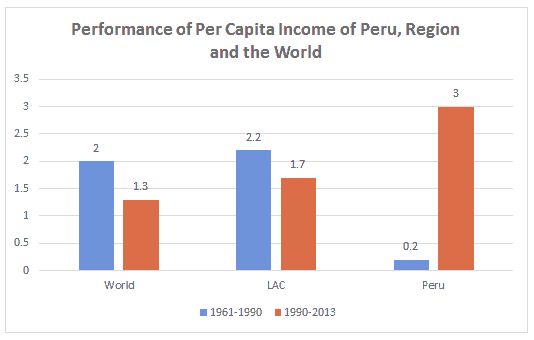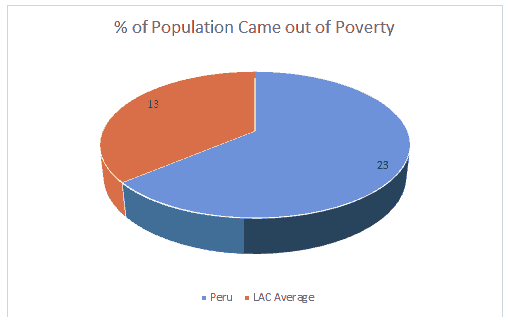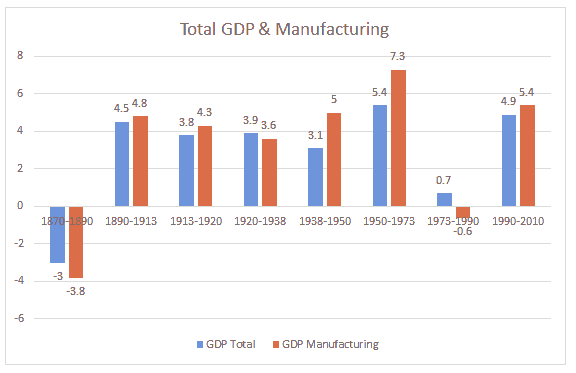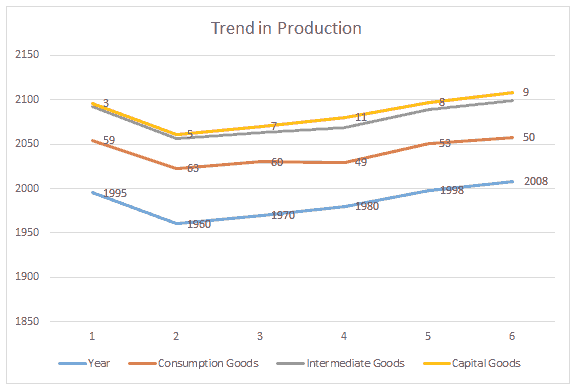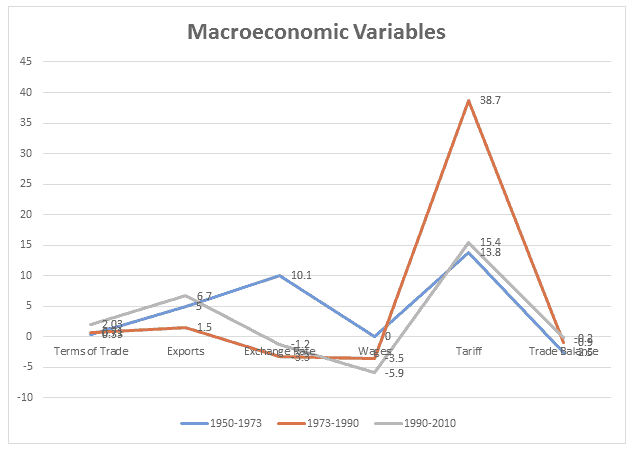Research Article: 2021 Vol: 20 Issue: 6S
Nexus Between Industrial Sector Contribution and Economic Development of Peru: An Analysis
Edwin Ramirez-Asis, Universidad Nacional Santiago Antunez de Mayolo
Juan Vilchez-Carcamo, Universidad Nacional Santiago Antunez de Mayolo
Edwin Asnate-Salazar, Universidad Nacional Santiago Antunez de Mayolo
Rosario Huerta-Soto, Universidad Nacional Santiago Antunez de Mayolo
Judith Flores-Albornoz, Universidad Nacional Santiago Antúnez de Mayolo
Magna Guzman-Avalos, Universidad Nacional Santiago Antunez de Mayolo
Abstract
In spite of global economic crisis, Peru is managed to stabilize its economy with a positive growth rate. The country is mainly worked on the process of controlling poverty. Industrial development is one of the prominent sectors for the development of Peru, it contributes 30.58 percent of the overall gross domestic product of the country in 2019. The unemployment rate at 6.6 percent in the same year alarming the policy makers to enhance the development of industrial sector. It requires a large quantum of capital flow generated from internal induced investment and also from the foreign direct investment. The manufacturing sector is in decline with negative of 1.7 percent in 2019. It was the steep fall from 6.7 percent of growth in the year 2018. Industrial production from agricultural-based industrial operations, pharmaceutical manufacturing, infrastructure, mining, energy and automobile industries to be enhanced with liberal monetary policy. Considering these elements, the present study aims to address the problems and opportunities of industrial sector development and economic progress through generating new employment avenues. Because the industrial sector contributes 32.7 percent of the total GDP. Among the total industrial sector, the mining industry, fishing industry and the manufacturing industry plays key contributions. On the whole, to conclude the study, the Peru has practising a well sustainable financial and economic growth in the recent decades. The country is established as a middle-income country from a low income country. Though, the improved condition of social and economic indicators, the country could not able to create more employment opportunities as desired or required by the people and the major goal of the country to eradicate poverty fully is not possible. Moreover, 50 percent of the people who engaged in economic activity are in informal sector.
Keywords
Industry, Manufacturing, Mining, Economic Growth & Development, and Peru.
Introduction
The Peru is emerging as a recent player of growth star among the Latin American countries and Caribbean area. The Peru’s economic growth is flowed at 6.4 percent on an average every year during the recent ten years. The country had a good growth in per capita income compared with other Latin American countries. It is also evident from the report that one-fourth of Peru’s population has been escaped from extreme poverty due to consistent economic growth. The major reason for this scenario is the per-capita income has increased by 6.8 percent. Moreover, it is observed that the decline in level of poverty and inequality has been driven by the increased in wages for labour force in the industry. With many policy reforms, the country is gained in promotion of macroeconomic stabilization such as control of inflation and deflation, initiation of independent central bank, free trade policy, flexible exchange rate and revamping of external debt, promotion of human capital, financial reforms, tax reforms and introduction of pension system and so on (The World Bank, 2015). The UNIDO considers the significance of the demand as a key driver of industrial growth. It represents that a crucial increase in consumption of industries could set in a light of virtuous sphere of manufacturing sector, which comprises of income creation, diversification of demand and wide creation of consumption (UNIDO, 2018). The industrial manufacturing is a process of production and its main objective is to change the raw material into proper commodities that have a worth in the outside market and as an outcome, created profit. The various factors such as effective, efficient, good product quality and trust. These elements evolve the way towards profitability of the industry through effective management as well. The manufacturing industrial segment is a key to the economy’s growth. Since, a long years ago, this industrial growth experiencing much changes to initiate the effectiveness in order to enhance production with good quality and it become more comfortable and competitive market.
Economic Trend in Peru
During 2019, the economic condition of Peru is grown at 2.2 percent, from a sharp slowdown from 4 percent experienced in the year 2018. It was as an outcome of worst external and domestic status that caused due to exports and government investment to stagnate. The deep decline in the external requirement from Peru has badly affected the exports, while output experienced difficulties in the mining industry, which had a prominent negative effects on manufacturing industries. These output shocks in the industries lead to the multiple reduction in government expenditure, which firmly affected the other subsystems of the economy. In the meantime, there was a significant hike in the private investment on industrial sector causes to increase the overall economy. The recent data exhibits that 1.5 percent of the GDP was the current account deficit. The major cause for the deficit was a decline in profits of foreign companies. The government has made an attempt to revamp the economy from the shocks through the expansionary monetary policy. So, the adoption of free credit policy supported the private and public investment to enhance the liquidity, it contributed a good portion to bridge the production gap. Employment rate has declined 63.5 percent to 62.8 percent in the year 2019 as compare with 2018. Based on the data in 2020, the economic activity down by 17.4 percent in the first two quarters. Because of the pandemic has begun leads to contraction in gross domestic product. Notwithstanding the initial lockdown procedures, the influence of the disease in the country was so severe. The public debt have also substantially increased by 35 percent of the total gross domestic product. The major area of concern was the employment during those days of pandemic. The core aim of the government is to promote the area of economic development and equitable economic upliftment and effective allocation of the resources. (United Nations, Economic Commission for Latin America and the Caribbean).
Literature Review
Oxford Business Group (2019) reported that small and medium organisations are the initiators for generating employment and income, which accounts for 33 percent of gross domestic product and 45 percent of the labour force in developed countries and over sixty percent of the GDP and 70 percent of employment in the growing economies. These industries have also being at the top on invention and innovation, taking benefit of the smaller scale and quickness related to larger industries to react more effectively to the technical and commercial avenues. However, the small scale operations in the industrial sector still facing the problems such as high tax burden, skill-set and capacity gaps, lack of formal credits and various trade barriers. The government across the world sought to reveal these problems by ratifying regularity modifications, enhancing knowledge, and generating free generation of funds for manufacturing sector. Infrastructural development plays an important role in economic growth. There is a positive correlation between infrastructural development and economic development (Urrunaga & Aparicio, 2013). Last two decades, the mining industrial sector in Peru is experiencing a sustainable growth. The study found that the mining industrial activities attract the inter-state migration inflows and has the positive influence on educational indicators. These developmental activities arise from the corporate social expenditure. The expansion of mining industrial activity increases the real income and enhances the standard of living of the people (Ticci & Escobal, 2015; Aragon & Rud 2009). The manufacturing sector is playing vital role in the growth the economy. The impact of China developmental issues and economic crisis affects the Peruvian labour market. Among the Latin America, the Peru has the largest size of labour market. Though, the manufacturing industrial sector is not a main in the Peruvian economic situation as it is in other economies in the Latin America. It considers a nontrivial basis of production and employment. An average of 16 percent of the economy’s gross domestic product during 2001-2010 and it concentrated 10.5 percent workforce in the year. Among the manufacturing sector in Peru, the largest manufacturing industries in terms of the contribution to the segment’s total value-addition are those connected metals, reserves and apparel (Pierola & Sanchez-Navarro, 2019). The MSMEs industrial sector plays a vital role in economic development of Peru. Though, the MSME is significant in economic development, the very tight accessibility to use of advancement in technology is one among the weakness of this kind of organisations, which denotes a lesser technological intensity in production, according to advanced technological trends. Moreover, the factors that are influencing the adoption of the industry 4.0 application in Peru’s MSMEs (Huang, 2019). One of the main familiar points of these businesses is that while they grow in size, the country economic condition would be affected and result of that, the various levels of poverty would decline. While, the real condition is that in few cases their performance and productivity would remain lesser for many years. However, their lesser performance could be allotted to the adverse situation affecting them, various previous researchers have faced many issues within organisation, particularly related to business management and decision-making (Bloom et al, 2010). To increase the growth through attracting the foreign investment, the country has replaced with highly safer labour methodology and flexible authorities (Pengerl, 2013).
Mining industry is also plays a major role in the development of the economy in Peru. Over the past few decades, the country has become the most successful in economic performance compare to other developing countries in LAC. The country is recording an average of growth of 6 percent in the recent years. The recovery of mining industry, during the period of high metal cost in the world market, it has been the vital driving force of Peru’s excellent growth track. The mineral wealth and output generated through the mining industry is the blessings of Peru and it navigated into growth of the whole economy. The nation experienced a high economic growth and simultaneously addressing the problem of poverty. People below the poverty line has drastically reduced under 26 percent of the total population of the country. As per the report by the Asian Development Bank, 50 percent of the population in Peru elevated to a middle-class family. In the recent changing business and economic scenario, a new pattern of the buying and consumption is requires the digital form of process and personalisation of commodities. It requires the industries to adopt and sustain a good degree of flexibility for their production processes. The SMEs in developing countries, particularly in Peru, are very relaxed to response for any sort modification, and often didn’t have the instruments to maintain the operations without slowdown their employment status (International Labour Organisation, 2019).
Objectives
• To understand the significance and contribution of Industrial sector in economic development.
• To identify the industrial driven economic growth in alleviating poverty in Peru.
• To analyse the income and employment generation from industrial sector for Peru’s GDP growth.
Data Analysis and Discussion
Based on the above objectives, the collected data from various sources has been tabulated and analysed. The performance of per capita income of Peru, region and the world level has been tabulated. It expresses the growth rate comparison between Peru and the rest of the world during 1961-1990 and 1990-2013.as shows in Table 1.
| Table 1 Performance Of Per Capita Income Of Peru, Region And The World |
||
|---|---|---|
| 1961-1990 | 1990-2013 | |
| World | 2 % | 1.3 % |
| LAC | 2.2 % | 1.7 % |
| Peru | 0.2 % | 3 % |
The above table emphasises the per capita performance of Peru compare with Latin American countries and the world. During the year 1961-1990, the per capita income of the world is reported as 2 percent compared to previous years. The Latin American countries had a good growth of average of 2.2 percent over last years and it was recorded with 0.2 percent in Peru for the same period. There was tremendous increase of 3 percent during 1990-2013 in Peru, but the LAC and the world registered the average growth rate of 1.7 percent and 1.3 percent respectively. Due to large efforts in generating the investment in major sectors including the major policy changes on industry led to a prominent growth of 3 percent in 1990-2013. The trade related policy also one of the reason to enhance the export of goods from Peru to the other countries. as shows in Figure 1.
Economic growth is one of the major cause for the alleviation poverty and vulnerability among poor people of the country. The proper industrial policy and implementation of various economic stabilisation adjustment strategies during the early stage of 1990s was the reason for the consistent and commendable speedy growth of Peru. However, the mining sectoe played a significant contribution in economic development through income and employment generation process. It records around 14 percentage of Peru’s gross domestic product and 60 percent of export. as shows in Table 2 and Figure 2
| Table 2 Poverty Alleviation Through Economic Growth |
|
|---|---|
| Country | % of Population Came out of Poverty |
| Peru | 23 |
| LAC Average | 13 |
The above table emphasises the percentage of population who came out of the poverty in Peru. The nation’s economic shock and failure forces and affect the quality of life of the people in Peru, particularly people who lives in remote and distant villages. The poverty and vulnerability have been disproportionately affected rural regions of the state, which is the home for several ethnic populations. The women is also firmly affected, often bearing the load of both home-work and engaging in agricultural activities. There are many initiative have been taken to arrest poverty through employment opportunities in rural and urban areas. The investment in industrial sector enables the employment opportunity. as shows in Table 3.
| Table 3 Total Gdp And Gdp Of Manufacturing Sector In Peru (In Percentages) |
||
|---|---|---|
| Time Period | GDP Total | GDP Manufacturing |
| 1870-1890 | -3 | -3.8 |
| 1890-1913 | 4.5 | 4.8 |
| 1913-1920 | 3.8 | 4.3 |
| 1920-1938 | 3.9 | 3.6 |
| 1938-1950 | 3.1 | 5 |
| 1950-1973 | 5.4 | 7.3 |
| 1973-1990 | 0.7 | -0.6 |
| 1990-2010 | 4.9 | 5.4 |
In table 3, it has been analysed that the total GDP growth percentage and the industrial manufacturing sector growth from the year 1870-1890 to 1990-2010. During 1870-1890 period, there was a negative growth of total GDP of Peru with -3 percent and the manufacturing sector recoded more negative that the total GDP of the nation with -3.8. But, the economy is bounced back to the positive growth during 1890-1913 by 4.5 percent of GDP growth and 4.8 percent of industrial manufacturing sector. After 1920 and till 1973, the average growth rate of manufacturing sector was above the average growth rate of the total GDP of Peru. It shows that there was a vital contribution made by the industrial manufacturing sector for the overall gross domestic product of the nation. There as small dip in the growth of manufacturing sector and the overall GDP due to various economic factors and economic crisis across the world. Again, during 1990-2010, the growth figures had bounced back at par with the normal situation at 4.9 percent and 5.4 percent for total GDP and the manufacturing sector GDP respectively. as shows in Figure 3.
The percentage share of production of various industrial commodities produced by Peru during 1995 to 2008 has been depicted in the below table. It shows very clearly that the consumption goods are playing a vital role in the overall output of the nation. Consistently, from 1995 it was contributing 59 percentage of total output, it was 63 percent in 1960 and 60 percent in 1970. There was a drop in 1980 with 49 percent share, the capital goods have penetrated by 5 to 6 percent of additional share as compared with previous years. as shows in Table 4, Table 5 and Figure 4.
| Table 4 Goods-Wise Output (Percentage Share) |
||||||
|---|---|---|---|---|---|---|
| Type of Goods | 1995 | 1960 | 1970 | 1980 | 1998 | 2008 |
| Consumption Goods | 59 | 63 | 60 | 49 | 53 | 50 |
| Intermediate Goods | 38 | 33 | 33 | 40 | 38 | 41 |
| Capital Goods | 3 | 4 | 7 | 11 | 9 | 9 |
| Table 5 Macroeconomic Variables |
||||||
|---|---|---|---|---|---|---|
| Year | Terms of Trade | Exports | Exchange Rate | Wages | Tariff | Trade Balance |
| 1950-1973 | 0.33 | 5 | 10.1 | - | 13.8 | -2.5 |
| 1973-1990 | 0.71 | 1.5 | -3.3 | -3.5 | 38.7 | -0.9 |
| 1990-2010 | 2.03 | 6.7 | -1.2 | -5.9 | 15.4 | -0.2 |
Along with the industrial development, the other important macroeconomic variables such as terms of trade, exports, exchange rate, wage rate, tariff and the trade balance of the country would also responsible for the development. These are the key element and indicators of the development of a nation. All these indicators are mainly depends upon the industrial production and growth. as shows in Figure 5.
Initiatives for the Promotion of Industries in Peru
• Modern Industrial Development Policy with Peru, programme jointly initiated by United Nations Industrial Development Organisation (2021) and ILO to support and enhance of a new industrial promotion policy.
• UNIDP arrangement for Capacity-Building and Transfer of Technology
Conclusion
The recent data exhibits that 1.5 percent of the GDP was the current account deficit. The major cause for the deficit was a decline in profits of foreign companies. The government has made an attempt to revamp the economy from the shocks through the expansionary monetary policy. So, the adoption of free credit policy supported the private and public investment to enhance the liquidity, it contributed a good portion to bridge the production gap. Employment rate has declined 63.5 percent to 62.8 percent in the year 2019 as compare with 2018. Based on the data in 2020, the economic activity down by 17.4 percent in the first two quarters. Improving institutional status by enhancing government policy for the development of new and creating industries and strengthen the various institutions at local and regional levels. During the year 1961-1990, the per capita income of the world is reported as 2 percent compared to previous years. The Latin American countries had a good growth of average of 2.2 percent over last years and it was recorded with 0.2 percent in Peru for the same period. There was tremendous increase of 3 percent during 1990-2013 in Peru, but the LAC and the world registered the average growth rate of 1.7 percent and 1.3 percent respectively. The percentage share of production of various industrial commodities produced by Peru during 1995 to 2008 has been depicted in the below table. It shows very clearly that the consumption goods are playing a vital role in the overall output of the nation. Consistently, from 1995 it was contributing 59 percentage of total output, it was 63 percent in 1960 and 60 percent in 1970. There was a drop in 1980 with 49 percent share, the capital goods have penetrated by 5 to 6 percent of additional share as compared with previous years. It is also advocated to improve the private –public partnership in the industrial sector. It is also important to develop the skill-sets of the micro level and small-scale producers for sustainable and creative industrial products. It will helps the industries to evolve new products and considerable contribute to the national income and employment generation. On the whole, to conclude the study, the Peru has practising a well sustainable financial and economic growth in the recent decades. The country is established as a middle-income country from a low income country. Though, the improved condition of social and economic indicators, the country could not able to create more employment opportunities as desired or required by the people and the major goal of the country to eradicate poverty fully is not possible. Moreover, 50 percent of the people who engaged in economic activity are in informal sector.
References
- Aragon, F., & Rud, J.P (2009). The blessing of natural resources: Evidences from a Peruvian gold mine. Working Paper No. 2009-015. Banco Central De Reserva Del Peru, University of London.
- Bloom, N., Mahajan, A., McKenzie, D., & Roberts, J (2010). Why do firms in developing countries have low productivity? American Economic Review, 100, 619-623.
- Fosten, A.L., Smith, C.L., & Au, T (1991). Fundamentals of computer-integrated manufacturing. New Jersey. USA: Prentice Hall, Englewood Cliffs.
- Huang, C., Chicoma, E.D.T., & Huang, Y. (2019). Evaluating the factors that are affecting the implementation of industry 4.0 technologies in manufacturing MSMEs, the Case of Peru. Processes, 7(4).
- International Labour Organisation (2019). SMEs in Peru transform to become more productive and competitive. Our Impact, their voices. Advancing Social Justice, Promoting Decent Work.
- Innovation Policy Platform (2016). Peru: STI Outlook 2016 Country Profile.
- Jameson, K.P. (1979). Designed to fail: Twenty-Five years of industrial decentralization policy in Peru. The Journal of Developing Areas, 14(1), 55-70.
- Oxford Business Group (2019). Support for small and medium-sized enterprises increasingly recognised as key to sustainable growth.
- Pengerl, S. (2013). Obstacles to SME growth in Peru: An empirical analysis of the effect of labour constraints on firm performance. Washington, DC: Georgetown University.
- Pierola, D.M., & Sanchez-Navarro, D. (2019). Import competition in the manufacturing sector in Peru: It’s impact on informality and wages. IDB Working Paper Series, Inter American Development Bank. Integration and Trade Sector.
- The World Bank (2015). Peru: Building on success- boosting productivity for faster growth. World Bank Group, Report No. 99400- PE.
- The World Bank (2013). Peru: A country committed to poverty reduction and shared prosperity. The World Bank Group in Peru.
- Ticci, E., & Escobal, J. (2015). Extractive industries and local development in the Peruvian highlands - Environment and development economics. Cambridge University Press, 20(1), 101-126.
- United Nations Industrial Development Organisation (2018). Industrial development report presented in Peru.
- United Nations Industrial Development Organisation (2021). Programme for country partnership: Peru. Sustainable Development Goals. Partnership Flat form
- United Nations Sustainable Development Goals Fund (2021). Case Study: Creative Industries Alleviate Poverty in Peru.
- Urrunaga, Roberto., and Aparicio, Carlos (2013). Infrastructure and economic growth in Peru. CEPAL Review, 107, 145-163.
